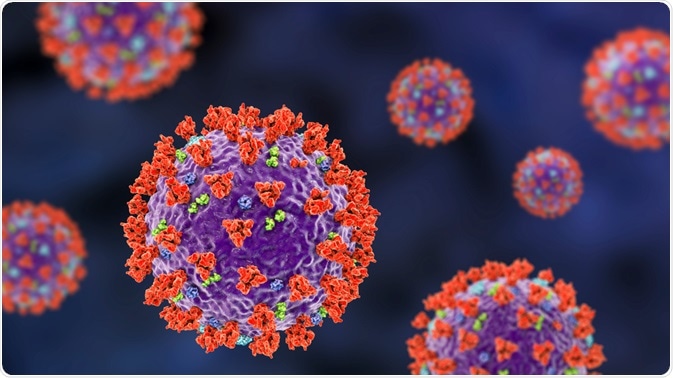A Sensitive Pseudovirus Assay for Screening SARS-CoV-2 Antibodies
The safety and versatility of pseudoviruses as virological tools have supported their use in assessing the efficacy and safety of vaccines and therapeutic agents against the novel severe acute respiratory syndrome coronavirus 2 (SARS-CoV-2).

SARS-CoV-2. Image Credit: Kateryna Kon/Shutterstock.com
Advantages of a pseudovirus system
Pseudoviruses are excellent tools for studying novel and highly pathogenic viruses that would otherwise require laboratory facilities of a higher biosafety level (BSL) of 3 or 4. In addition to avoiding exposure to highly contagious viruses, the pseudovirus system is also associated with several advantages including rapid production and ease of quantification.
Furthermore, progeny viruses are only capable of undergoing a single replication cycle, thereby further supporting the safety of this system.
What are pseudoviruses?
Pseudoviruses are made from components that have originated from two different viruses. The surface glycoprotein component is from the virus intended for study, whereas the inner core genome is derived typically from a vesiculo virus or virus.
Some examples of the viruses that have been used to provide the inner core genome for the generation of SARS-CoV-2 pseudoviruses include the vesicular virus of vesicular stomatitis virus (VSV), as well as several different retrovirses including the human immunodeficiency virus (HIV), murine leukemia virus (MLV), and feline leukemia virus (FLV).
The pseudovirus system for research
To date, pseudovirus-based The core genome of a pseudovirus is altered so that the virus proteins responsible for facilitating replication, including the native glycoprotein, are deleted. Instead, a reporter protein-encoding for an enzyme, such as luciferase, or another type of fluorescent protein is incorporate.
Pseudoviruses, therefore, infect susceptible cells only once and cannot undergo further replication. However, upon pseudovirus infection, the reporter protein is expressed with an activity that can be sensitively quantified as needed.
For successful pseudovirus infection, the cells must express pertinent receptors that bind the surface glycoprotein to permit pseudovirus entry and. Allowing for the infection of a pseudovirus can therefore provide appropriate viral entry pathways that are needed to study the contagious virus of interest.
Challenges in studying SARS-CoV-2
In December 2019 a novel coronavirus known as SARS-CoV-2 originated in Wuhan, China, and subsequently spread throughout the globe resulting in a coronavirus disease 2019 (COVID-19) pandemic. Due to the highly pathogenic and transmissible nature of SARS-CoV-2, CDC guidelines recommend that any laboratory work carried out with SARS-CoV-2 must be performed at a higher biosafety level of BSL-3 or -4.
However, both BSL-3 and -4 laboratories are limited to a few institutions. This limitation restricts large-scale testing of the efficacy of vaccines and therapeutic monoclonal antibodies targeted against SARS-CoV-2 spike (S) glycoprotein. One alternative would be to employ SARS-CoV-2 S pseudoviruses.
Pseudovirus systems for studying SARS-CoV-2
Since the emergence of SARS-CoV-2, several different pseudovirus-based approaches have been utilized to study this disease and evaluate the efficacy of certain therapeutic agents. In one recent study, a pseudovirus-based neutralization assay (PBNA) was developed to evaluate the neutralization of certain antibodies against SARS-CoV-2.
Briefly, the VSV system was used and confirmed to display the SARS-CoV-2 spike protein on the surface of the VSV particle through Western-blot analysis. /Once the SARS-CoV-2 S pseudotyped virus was generated, a total of seventy-four human and forty-six mouse serum samples were tested to evaluate the specificity of the assay.
The limit of detection for this assay was found to be 22.1 for the human samples and 43.2 for the mouse samples, with cutoff values set as 30 and 50 for human and mouse samples, respectively. Taken together, this assay was found to have low coefficient variations with 15.9% for the intra-assay analysis and 16.2% for the inter-assay analysis.
Neerukonda and colleagues have also developed a highly sensitive assay that employs SARS-CoV-2 S pseudoviruses for screening serum or plasma from COVID-19 patients and vaccinated individuals, as well as evaluating the efficacy of therapeutic monoclonal antibodies. In this study published in PlosOne, the researchers established cell and pseudovirus reagents that produce high pseudovirus yields and infection to facilitate massive scale screening of antibodies and entry inhibitors against COVID-19.
To confirm the utility of this screening assay, the researchers used a stable 293T cell line that expresses human angiotensin-converting enzyme 2 (ACE2) and transmembrane serine protease 2 (TMPRSS2). The binding of the S protein on the surface of SARS-CoV-2 to the ACE2 receptor of cells mediates the entry of this virus into target cells, as well as catalyzes the fusion of the viral and cell membranes. TMPRSS2, as well as cathepsins B and L, are also critical for efficient entry of SARS-CoV-2 into cells, particularly within the epithelial cells of the lungs.
Notably, this is an HIV-based assay that has been found to be more advantageous than VSV in terms of the time required to generate pseudoviruses (2 days versus 5-6 days) and conduct screening. This SARS-CoV-2 lentiviral PBNA and its reagents are currently being used by researchers and public health agencies worldwide at an extraordinary scale to evaluate the neutralizing potential of vaccine-induced immune responses against existing and emerging SARS-CoV-2 variants.
References:
- Neerukonda, S. N., Vassell, R., Herrup, R., et al. (2021). Establishment of a well-characterized SARS-CoV-2 lentiviral pseudovirus neutralization assay using 293T cells with stable expression of ACE2 and TMPRSS2. PLOS ONE 16. doi:10.1371/journal.pone.0248348.
- Huang, S., Tai, C., Hsu, Y., et al. (2020). Assessing the application of a pseudovirus system for emerging SARS-CoV-2 and re-emerging avian influenza virus H5 subtypes in vaccine development. Biomedical Journal 43(4); 375-387. doi:10.1016/j.bj.2020.06.003.
- Nie, J., Li, Q., Wu, J., et al. (2020). Establishment and validation of a pseudovirus neutralization assay for SARS-CoV-2. Emerging Microbes & Infections 9(1); 680-686. doi:10.1080/22221751.2020.1743767.
Last Updated: Apr 26, 2021

Written by
Benedette Cuffari
After completing her Bachelor of Science in Toxicology with two minors in Spanish and Chemistry in 2016, Benedette continued her studies to complete her Master of Science in Toxicology in May of 2018.During graduate school, Benedette investigated the dermatotoxicity of mechlorethamine and bendamustine; two nitrogen mustard alkylating agents that are used in anticancer therapy.
Source: Read Full Article
